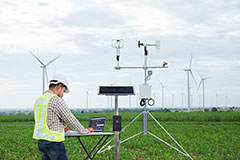
As yet, procedures for processing and distributing these derived data sets are not standardized. Regular archiving of these data is often required at even coarser resolution. Meteorological satellites have either continuous or daily global coverage, but they are often limited in their spatial resolution as a result of the high altitude of their orbits.

Meteorological satellites can provide an alternative means of obtaining weather data to drive ecosystem models. The processed images will be disseminated by an S-band receiving antenna and an L-band transmitting antenna in HRIT and LRIT format of weather data, respectively. CMDPS produces 16-baseline meteorological products including atmospheric motion vector, water vapor distribution, aerosol information, and cloud distribution using the Level 1B data and ancillary data and transmits them to LHGS. LHGS performs the LRIT/HRIT formatting for user dissemination. The generated Level 1B data are sent to the LRIT/HRIT Generation System (LHGS) for user dissemination and CMDPS for further data analysis. IMage Preprocessing System (IMPS) receives raw data from DATS and then performs radiometric and geometric corrections. It also modulates LRIT/HRIT and transmits them to the spacecraft. It receives sensor data from the antenna system and demodulates the MI raw data. Data Acquisition and Transmission System (DATS) performs the front-end process. In order to perform this mission, NMSC developed the infrastructure for the COMS MI user data (LHGS, IMPS operational data, and LRIT/HRIT additional data) generation, system interface control, data archiving, and service control system. NMSC/KMA is responsible for the real-time operation of the data processing and dissemination through IDACS.
#Meteorological instruments and their uses registration#
INRSM (Image Navigation and Registration Software Module) IDACS configuration and functionalities at NMSC are shown in Fig. 4 –

IRCM (Image Radiometric Correction Module) Have confidence in the atmospheric data and equipment you use for your local weather monitoring initiatives with Met One Meteorological Systems.DATS (Data Acquisition and Transmission Subsystem) – Procuring accurate data is easier than ever with our CCS Comet Cloud+ Modem, which transmits remote data directly to the cloud for access anywhere on your smartphone or computer. With the addition of the ES-405 or the E-BAM, many weather groups are now including Air Quality Index (AQI) in their local reporting, to add extra peace of mind, or provide valuable warnings to the local population. Our meteorological systems, comprised of our time-tested, rugged weather sensors and accessories, are used for research, regulatory compliance, process control, health and safety, and local weather reporting by industry, academia, military, and government agencies.


Our Systems department is also available to customize your meteorological system to specific needs or unique environments. Met One Instruments offers four standard packaged meteorological systems to measure atmospheric and local weather conditions, including the General Purpose Weather Station, the Industrial Weather Station, the Rapid Response Weather Station, and the Air Quality Weather Station.


 0 kommentar(er)
0 kommentar(er)
